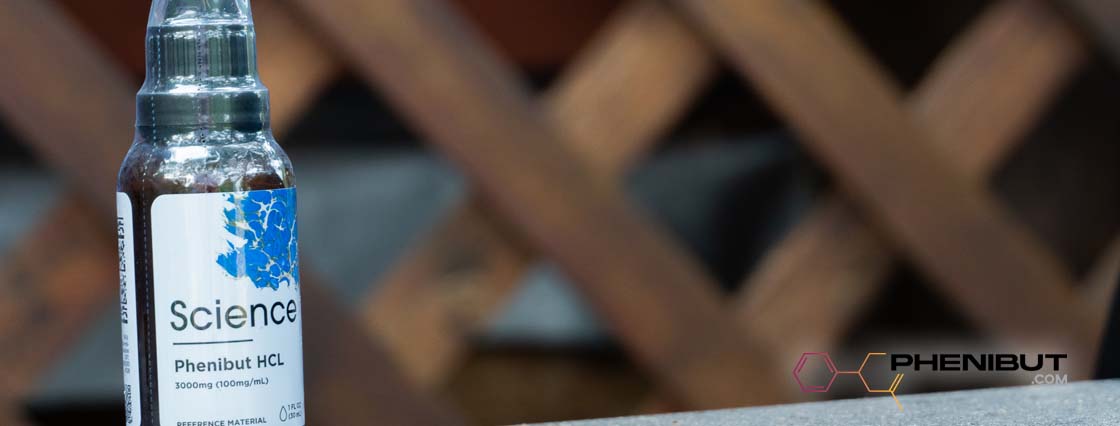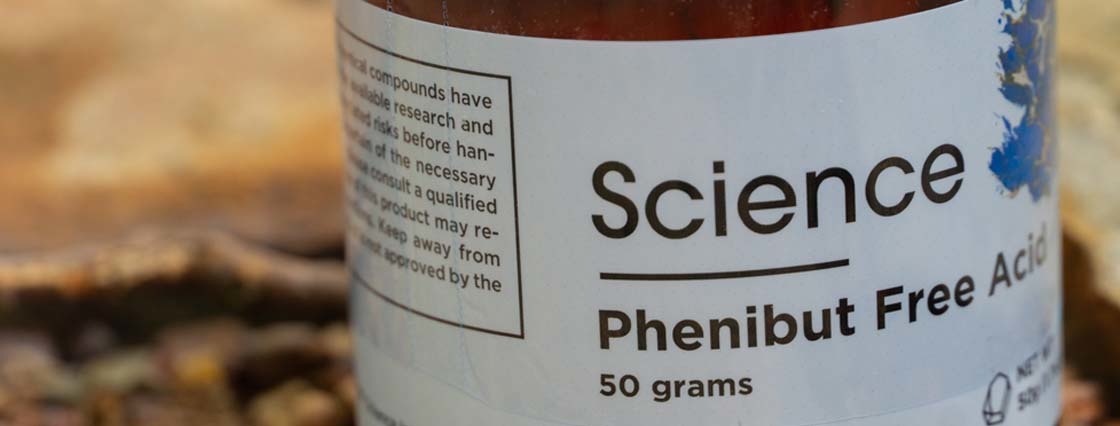Phenibut is a widely researched nootropic due to its potential to boost creativity, improve mood, and reduce anxiety, particularly in social situations…but is phenibut safe?
There are well-founded concerns about phenibut addiction. Phenibut also comes with side effects. Accordingly, researchers should carefully design their studies to mitigate the possibility of side effects and physical dependence in human subjects.
On the whole, however, phenibut is generally well-tolerated by healthy adult subjects who follow an appropriate dosing protocol.
Keep reading as we go over the safety issues to consider when designing your phenibut research study.
Order Phenibut online from the best vendor in the world!
Great prices, quick shipping, and guaranteed delivery.
Disclaimer: Phenibut.com contains information about products that are intended for laboratory and research use only, unless otherwise explicitly stated. This information, including any referenced scientific or clinical research, is made available for educational purposes only. Phenibut.com makes every effort to ensure that any information it shares complies with national and international standards for clinical trial information and is committed to the timely disclosure of the design and results of all interventional clinical studies for innovative treatments publicly available or that may be made available. However, research is not considered conclusive. Phenibut.com makes no claims that any products referenced can cure, treat or prevent any conditions, including any conditions referenced on its website or in print materials.
What Is Phenibut?
Phenibut is a neuropsychotropic drug with anti-anxiety and cognitive-enhancement effects. It is generally classified as a central nervous system depressant [1].
Phenibut’s structure is similar to that of a chemical signaler found in the human body: a neurotransmitter called GABA [2].
GABA and neurotransmitters
Neurotransmitters are chemicals that send messages throughout your nervous system. They help your brain regulate your body and feelings. Some neurotransmitters are excitatory, which means that they increase the excitation of your neurons so that they fire more.
GABA is the opposite: it's inhibitory. That means that it decreases the firing of nerve cells and calms them down. That may not sound like a good thing, but it is. There are lots of times you actually want a calmer brain: when you're trying to sleep, when you’re overly anxious, and so on. You would not want your brain firing at all times.
Phenibut mimics GABA
Because phenibut mimics GABA, it binds to GABA receptors and has effects similar to GABA itself. Phenibut binds primarily to the slow-acting GABAB receptors. [3]
Because phenibut binds to the GABA receptors, it also has a role in inhibiting neural functions and reducing excitability. As a result of this, phenibut has been shown, in certain populations, to produce benefits like less stress, less anxiety, improved cognition, and better sleep.
In countries like Russia and Latvia, phenibut has long been prescribed to treat or relieve conditions like anxiety, insomnia, PTSD, and alcohol use disorder [1, 3].
Classification
Phenibut is a prescription drug in a handful of countries, including Russia, Latvia, and Belarus. In the United States, phenibut is a “New Drug” under the Federal Food, Drug, and Cosmetic Act (FD&C Act) and is not approved for use as a medication. Its status means that it is available for use by qualified researchers.

Is Phenibut Safe?
We know that it mimics GABA…but is phenibut safe?
Phenibut is generally well-tolerated based on the literature and clinical experience. Still, there are certain points of which phenibut researchers should be aware:
- Phenibut can cause side effects and allergic reactions. While uncommon, these can happen to anyone.
- Phenibut can cause interaction effects when it is mixed with other substances.
- Phenibut use can lead to addiction. This can happen to subjects who take too much phenibut, too often.
- Phenibut use can result in an overdose. This happens to individuals who take too much phenibut at once.
These points have considerable implications for the drug’s safety, and we'll cover each in detail below.
Phenibut Side Effects
There are phenibut side effects of which researchers should be aware.
The chance of experiencing these is typically related to the dose ingested: the greater the dose, the more likely the occurrence of side effects. But, it's possible to see side effects at any dose, so it's best to understand the risks so you can take precautions to keep your research subjects safe.
More common and milder phenibut side effects
Phenibut side effects that are milder in nature, yet more common, include [4, 5, 6, 7]:
- Drowsiness or sleepiness
- Sedation
- Headaches
- Agitation or anxiety
- Nausea (and, less often, vomiting)
- Dizziness
Less common and more severe phenibut side effects
At high doses, there have been reports of phenibut causing more severe side effects (although these are also less common) [5, 8]:
- Hallucinations
- Delirium
- Loss of consciousness
- Low blood pressure
- Excessive muscle relaxation or tremors
Side effects are more likely with higher doses. Instructions of phenibut for use as a prescription medication state that 750 mg is the maximum dose at any given time, with 2.5 g given as the daily maximum [4 in Russian]. Doses above those levels will put test subjects at higher risk for adverse effects.
Most phenibut research uses dosing protocols well below those levels. See our article on phenibut dosage for more details.
Phenibut interaction effects
Phenibut safety requires being aware of interaction effects.
Interaction effects occur when one medication interacts with another. In general, one wants to avoid taking medications that work on the same pathways or have similar effects because they can augment or exaggerate the effects of each other.
Phenibut is an inhibitory neurotransmitter, which means that it reduces neuronal excitation. Accordingly, your test subjects should avoid consuming it with other inhibitory substances (or “downers”).
It also works on the GABA pathway [9], so it’s a good idea for your test subjects to stay away from other substances that use the GABA pathway while they’re participating in phenibut research. For those reasons, advise your test subjects to avoid using the following when consuming phenibut [4]:
- Alcohol
- Benzodiazepines
- Anticonvulsant medications
- Antipsychotic medications
- Sedatives
- Opiates
- Barbiturates
Phenibut test subjects who stay away from these downers and GABA modulators can decrease the risk of experiencing interaction effects.

Is Phenibut Addictive?
Phenibut can be addictive. Nootropic researchers should consider including precautions to help test subjects avoid developing tolerance or addiction.
Physical addiction happens when an individual’s body gets used to a substance, recalibrating itself to account for the drug [10]. If the body sees that an individual has lots of GABA, it stops making its own GABA and may even start clipping away GABA receptors.
Broadly speaking, this can have two effects: (i) it will cause the phenibut subject to feel less phenibut effects, and (ii) it can also cause the individual to need phenibut to function normally.
When our hypothetical subject tries to stop using phenibut, they’ll get a variety of physical side effects called withdrawal symptoms [11].
This is a scenario to avoid.
There are several side effects that come with phenibut dependence and withdrawal, including:
- Confusion
- Dizziness
- Fatigue
- Nausea
- Loss of appetite
- Insomnia
- Restlessness and irritability
- Rebound anxiety
- Panic attacks
- Increased sensitivity to light and sound
- Heart palpitations
- Muscle twitches and tremors
- Hallucinations
How can you help your research subjects avoid dependence?
You can design your research protocol to avoid the excessive usage of phenibut. Here is a possible set of dosing guidelines:
- Test subjects are given phenibut no more than 1 to 2 times per week.
- Test subjects are given no more than 2 grams per day.
Phenibut Overdose?
Is phenibut overdose within the realm of possibility?
Yes. An overdose happens any time an individual takes more than the recommended dose of a substance.
In the United States, there has been at least one reported death from a phenibut-only exposure [12]. Information on the circumstances surrounding that death is not publicly available.
We have guides on phenibut dosage and also on taking phenibut properly. These guides should help you design a study protocol that maximizes the safety of your participants.
Clinical experience shows that problems do arise when individuals take an excessive phenibut dose.
For example, in one case, a 20-year-old woman overdosed on phenibut and presented at the hospital with decreased consciousness and delirium. She ingested a significant amount, seeing as her plasma phenibut concentration was 29.7 μg/ml. Her symptoms cleared up within a day. In a similar case, a man took an excessive dose of phenibut, this time together with marijuana and alcohol, and also experienced delirium. His plasma phenibut concentration was even higher at 36.5 μg/ml. He also made a full recovery [8].
In an extreme case, a man took up to 30 grams of phenibut (about 12 times the maximum daily amount) and was admitted to an intensive care unit. He experienced ongoing episodes of drowsiness and agitation. Following sedation and intubation, he also made a full recovery within a 24-hour period [6].
These cases highlight the real possibility of phenibut overdose and the need to exercise extreme care when setting a dosing protocol for study participants.
How Often Can You Take Phenibut?
While some research has participants taking phenibut every day over the course of a study period [1], this frequency may put test subjects at risk for dependence. Instead, having test subjects take phenibut once or twice a week is a more cautious approach that may put test subjects at less risk of developing dependence.
Benefits of Phenibut
The potential benefits of phenibut may be significant.
- Phenibut is a purported nootropic, so it may provide enhanced cognition. Research has found that, in a very small sample of human participants with anxiety-phobic disorder, phenibut may improve memory, attention, and emotional intelligence [13]. There is also some preliminary evidence from an experiment on a small sample of rabbits that phenibut may improve some types of learning [14].
- Phenibut appears to lower anxiety while boosting mood. The drug appears to significantly reduce anxiety while simultaneously improving mood, with evidence provided from several clinical studies, as summarized by Dr. Lapin [1]. These changes may be due to reduced activity in the hippocampus and neocortex [15].
- Phenibut may improve sociability. Some research suggests that phenibut may improve sociability [5]. If there is an effect of phenibut on sociability, it may arise from improved emotional intelligence coupled with lower anxiety.
- Phenibut appears to improve sleep. Remember how GABA helps relax the brain? So does phenibut, and that may be why it can support sleep. This has been found in several studies on phenibut and sleep, which show that, for some individuals with sleep disorders, phenibut can provide a statistically significant improvement in disordered sleeping symptoms [16, 17, 18].
Where to Buy Phenibut Online? | 2022 Guide
Where can you buy phenibut for your research?
Our favorite online vendor is Science.bio. Here’s why we love them:
- They offer research-grade phenibut at reasonable prices. As of this writing, a 50g jar of phenibut HCL powder costs $24.99, while their 50g FAA powder is $29.99. You can also go for one of their ultra-potent F-Phenibut powders.
- They post certificates demonstrating the purity of their phenibut from independent studies. This shows us that Science.bio is transparent about what's in their product.
- They have a great return and refund policy. It makes us feel comfortable that if we have a problem, they'll fix it (and they always have).
- They've got a number of convenient payment options, like credit cards and Bitcoin.
- They've got a great support team. If you have a problem, Science.bio will fix it.
Ready to order Phenibut from the top-rated online vendor?
Phenibut Safety and Side Effects | Verdict
So, how safe is phenibut?
Existing data shows that phenibut is generally well-tolerated. Of course, you do need to take some precautions in your own research.
Be aware that test subjects may experience side effects. These can be avoided by following prudent dosing guidelines and ensuring that subjects are well-informed about interaction effects. To avoid the development of tolerance and dependence, ingestion frequency should be limited to no more than one to two times per week.


